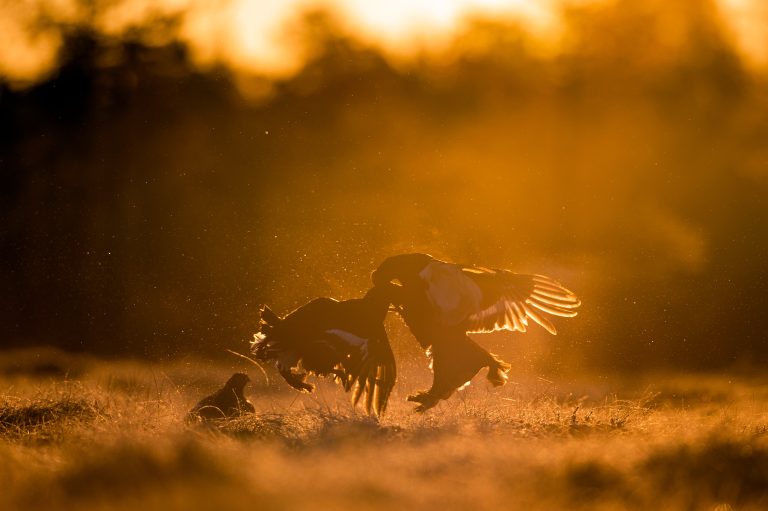Birds in spring
In April its the lek of the black grouse and capercaillie.
Its very special to watch them close!
Booking requests only to pierrickmeuillet@gmail.com

Black grouse
Black grouse watching is an exciting and unique wildlife experience, especially during the lekking season when male black grouse display their plumage and calls to attract females. This thrilling opportunity is perfect for bird enthusiasts and photographers, but it requires preparation, fitness, patience, and comfort.
Key aspects of Black grouse watching
1. Fitness Requirement
- Clients should be fit enough to walk 900 meters through damp, marshy, and uneven terrain.
- Sturdy, waterproof footwear is essential as the walk can be challenging, especially in the early morning when the ground is slippery.
- The damp conditions can make the walk feel longer, so mental preparedness is important.
2. Spending the Night
- The experience involves staying overnight in the area, requiring warm sleeping bags.
- Nights can be chilly, especially in remote or high-altitude locations, so proper bedding is crucial.
- Preparing for cooler temperatures ensures a comfortable night before the early morning start.
3. Long Hours Lying Down
- Clients will spend several hours in hides, often lying down in confined spaces.
- This can be physically demanding, so bringing cushions or mats for added comfort is advised.
- Proper clothing is necessary to stay warm and dry while remaining still.
4. The Lekking Behaviour
- The lek is a spectacular display where male black grouse puff out their chest, call, and show off their plumage to attract females.
- This activity peaks in the early morning hours, requiring an early wake-up.
- The lek provides excellent photo opportunities, especially in the soft dawn light.
5. The Tragopan Hokki V2 and V3 Hides
- These hides are ideal for bird-level photography, offering a unique close-up perspective.
- However, they are not very spacious, so clients should be prepared for tight conditions.
- Those with larger builds or discomfort in confined spaces should take this into consideration.
6. Practical Considerations – Urination Needs
- Clients should bring a bottle for urination due to the long hours in the hides.
- Leaving the hide could disturb the birds, so planning for this necessity is essential.
- A discreet container ensures the experience remains uninterrupted.
Preparation Tips:
- Footwear: Sturdy, waterproof boots are essential for navigating damp, uneven terrain.
- Clothing: Dress in layers and bring extra clothing for warmth, as mornings can be cold, and it’s important to stay warm during the night and while waiting in the hide.
- Sleeping Bags: Bring a high-quality, warm sleeping bag to ensure comfort and warmth overnight.
- Patience and Comfort: Since the hides are compact and you’ll be lying down for extended periods, it’s important to be patient. Foam mats and sleeping pads are provided for extra comfort. Make sure to dress in comfortable, flexible clothing suitable for lying down for several hours.
- Physical Stamina: Clients should be prepared for the physical demands of the experience, including the walk to the lek, long hours of stillness in the hides, and the need to stay alert and quiet to avoid disturbing the birds.
- Practical Items: Don’t forget a bottle for urination, as leaving the hide can disrupt the experience and disturb the birds.
By preparing for the physical and practical aspects of the experience, your clients can make the most of this incredible opportunity to photograph the black grouse and witness their lekking displays in their natural habitat.

Capercaillie
Capercaillie watching is an exciting and unique experience, especially during the breeding season when these majestic birds perform their dramatic courtship displays. However, the timing and logistics are key to ensuring the best viewing opportunities, as capercaillies have specific behaviors and routines that must be considered.
- Location and Terrain
The lek area is located close by the parking spot, within only a few hundred metres walk. However, proper footwear (waterproof boots) and weather-appropriate clothing are essential for navigating this terrain comfortably.
- Timing: Taking Place in the Hides Before 17:00
The capercaillie experience is carefully timed to align with the birds’ natural behavior. Unlike black grouse, capercaillies typically come to the lekking site or feeding areas in the late afternoon and then fly up to trees to roost for the night. As a result, it’s crucial for clients to take their place in the hides before 17:00.
- Why Before 17:00?: Capercaillies are known to arrive at their roosting trees around late afternoon or early evening, typically before dusk. To ensure minimal disturbance and to give clients the best opportunity to observe the birds, everyone must be in the hides by this time.
- Arriving Early: This means that the group must arrive at the hide well in advance, as the birds are shy and sensitive to human presence. Any movement or noise could cause the birds to become startled and fly away, making it harder to observe them.
- Practical Note: Once settled in the hides, clients will need to remain still and quiet for the duration of the evening. This quiet observation period is key to not disturbing the birds and ensuring they feel safe in the area.
- The Capercaillie Lekking and Roosting Behaviour
Capercaillies, particularly the males, are known for their dramatic courtship displays during the breeding season, which typically occur at dawn. However, in the late afternoon and evening, the birds start to arrive in the forest to roost in the trees for the night.
- Roosting Behaviour: The males usually head to specific trees to spend the night, and they often choose tall, mature trees with dense foliage for protection. It’s essential to be settled in the hides by 17:00 to ensure a good chance of observing the birds as they fly up to their roosting spots.
- Evening Wait: While the lekking display happens primarily at dawn, the evening is an excellent opportunity to see capercaillies in their natural resting phase.
- The Hides
As with other wildlife watching activities, hides are used to minimize human disturbance and allow for close observation without scaring the birds. These hides are typically camouflaged to blend into the forest environment and provide clients with optimal viewing angles.
- Comfort: The hides are generally designed to be comfortable for long periods of waiting, though they may be a bit cramped, so clients should be prepared to sit still for several hours. On location, we provide cushions mats for added comfort, bring warm layers to stay cozy, and a bottle for urination in case leaving the hide would disturb the birds.
- Patience and Practical Considerations
Watching capercaillies requires a significant amount of patience. The birds are not always easy to spot, and the waiting can take several hours. However, the experience is rewarding for those who appreciate wildlife observation and photography.
- Hydration and Snacks: Bring water and light snacks to maintain energy levels while waiting.
- Quiet and Stillness: Once in the hide, clients need to remain quiet and still. Any movement or noise can scare the birds, and since they are sensitive to human presence, it’s crucial to remain calm and composed for the best chance of success.
- The Photography Aspect
The lekking displays occur at dawn, the evening offers a chance to photograph the birds as they roost or fly into trees.
- Camera Gear: A telephoto lens is recommended for capturing the birds from a distance without disturbing them. A tripod will also help to maintain stability, especially when shooting in low light conditions.
Conclusion
Capercaillie watching offers an incredible opportunity to observe one of Europe’s most majestic birds, but it requires careful planning and timing. Clients must be in their hides before 17:00 to ensure they are settled and ready to observe the capercaillies as they arrive at their roosting sites for the night. The experience involves patience, quiet observation, and preparation for several hours of waiting in the hides. By following these guidelines, clients can maximize their chances of experiencing and photographing these beautiful birds in a natural, undisturbed environment.
Booking requests only to pierrickmeuillet@gmail.com
